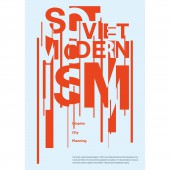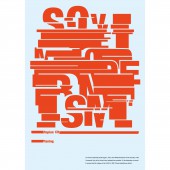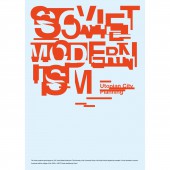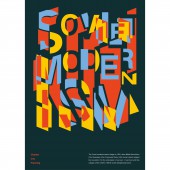
| THE AWARD |
| CATEGORIES |
| REGISTRATION |
| SUBMIT YOUR WORK |
| ENTRY INSTRUCTIONS |
| TERMS & CONDITIONS |
| PUBLICATIONS |
| DATES & FEES |
| METHODOLOGY |
| CONTACT |
| WINNERS |
| PRESS ROOM |
| GET INVOLVED |
| DESIGN PRIZE |
| DESIGN STORE |
| THE AWARD | JURY | CATEGORIES | REGISTRATION | PRESS | WINNERS | PUBLICATIONS | ENTRY INSTRUCTIONS |
Utopian City Poster by Qiuyu Li |
Home > Winners > Design #133174 >Interview |
 |
|
FS: What is the main principle, idea and inspiration behind your design?
QL: The inspiration for this design is 1920s modern typography. The purpose is to study the future development and possibilities of modern typography based on the modeling philosophy that was sought at that time. Rather than mechanical and groundbreaking, this design seeks freedom of modeling. Strictly speaking, we are pursuing a good balance between mechanical and free.
FS: What has been your main focus in designing this work? Especially what did you want to achieve?
QL: The array of letters is the focus. Achieve visual stimulation without traditional modern typography through random size and arrangement.
FS: What are your future plans for this award winning design?
QL: We will do our best to further develop this series and find many possibilities. We also believe that this means of design expression is applicable to other designs. I would like to experiment a lot on this.
FS: How long did it take you to design this particular concept?
QL: It doesn't take much time to produce, but collecting and organizing materials takes the longest time.
FS: Why did you design this particular concept? Was this design commissioned or did you decide to pursuit an inspiration?
QL: This design is my doctor's research work. Originally strongly influenced by modern typography, but with the changing times, I really wanted to break through the limits of modern typography, so I started this research.
FS: Is your design being produced or used by another company, or do you plan to sell or lease the production rights or do you intent to produce your work yourself?
QL: This design was created for the purpose of experimentation. Although not for commercial purposes, this design's means of modeling, if established as a theory, could be applied commercially in the future.
FS: What made you design this particular type of work?
QL: First, I was influenced by the 1920s design, which I like. Besides, I have been doing design research on typography for a long time, so I was also quite interested in further expanding the new possibilities of typography.
FS: Where there any other designs and/or designers that helped the influence the design of your work?
QL: Representative of Constructivism, El Lissitzky
FS: Who is the target customer for his design?
QL: El Lissitzky produced many experimental works to create a new culture for the new Soviet society of the time.
FS: What sets this design apart from other similar or resembling concepts?
QL: This typographic work is derived from and influenced by modern typography, but instead of arranging the letters in a linear grid system as in modern typography, the architectural elements serve as guides, and the letters are arranged randomly. More possibilities of form can be created.
FS: How did you come up with the name for this design? What does it mean?
QL: All the elements that appear in this design are derived from Soviet-era buildings, and the features of Soviet modernist architecture eliminate all decorations and are built in a similar style, which makes the cityscape very groundbreaking. It looks like the scenery I wrote in Thomas More's book "Utopia".
FS: Which design tools did you use when you were working on this project?
QL: I always use Adobe Illustrator on working.
FS: What is the most unique aspect of your design?
QL: Incorporated cultural aspects, we are prejudiced and things are not easy to see. I try my best to see things from a prejudiced and objective standpoint.
FS: Who did you collaborate with for this design? Did you work with people with technical / specialized skills?
QL: Now I design and produce almost exclusively by myself. One person is more flexible, but there is a limit to what one person can do. If possible, I wish I could collaborate with someone else in the future.
FS: What is the role of technology in this particular design?
QL: This poster series was created to expand the possibilities of typographic modeling. This means of modeling may serve to indicate one direction of typographic expression.
FS: Is your design influenced by data or analytical research in any way? What kind of research did you conduct for making this design?
QL: The mechanics of character alignment are influenced by modern typography. Since this design is characterized by the incorporation and utilization of architectural elements, it is necessary to examine the material research phase and many photographic documents of Soviet-era buildings.
FS: What are some of the challenges you faced during the design/realization of your concept?
QL: I think it was the influence of the old modern typography. Because it is unconsciously affected.
FS: How did you decide to submit your design to an international design competition?
QL: It depends on the influence and popularity of the competition.
FS: What did you learn or how did you improve yourself during the designing of this work?
QL: We have some direction for the new possibilities of modern typography.
FS: Any other things you would like to cover that have not been covered in these questions?
QL: We believe it is worthwhile to explore in this direction in the future to see what effect this means of modeling can have when applied to Chinese characters.
FS: Thank you for providing us with this opportunity to interview you.
A' Design Award and Competitions grants rights to press members and bloggers to use parts of this interview. This interview is provided as it is; DesignPRWire and A' Design Award and Competitions cannot be held responsible for the answers given by participating designers.
| SOCIAL |
| + Add to Likes / Favorites | Send to My Email | Comment | View Press-Release | Translations |





